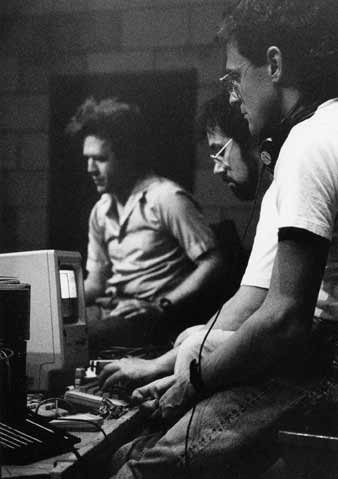4.3 Wheelies
Wheelies (1992) designed by Chris Brown, used the computer network band
as a giant, multi-limbed, rhythm machine. The purpose was to create variations
on complex rhythmic synchronizations among the players' machines, while
allowing players to control each other's rhythmic performance. Each player
programmed the implementation of their system, and could change the voicing
of their instrument's rhythms, but all were locked into a tempo set globally
for the group, while their ICTUS, METER, and DENSITY parameters were set
and changed during the performance by other players, but never by themselves.
audio track of Wheelies

A screen shot from Chris Brown's Wheelies software, showing the HMSL shape editor (a software language written at Mills College by Phil Burk, Larry Polansky and David Rosenboom) for editing the tempo curves in the piece.
MIDI clock signals were generated by Chris and broadcast to the whole
group, which set down a common, but changing tempo that all players locked
to. This tempo was divided by each player independently by a number from
1 to 10 set by the ICTUS parameter. METER set the rhythmic cycle, implemented
as the repetition of notes or timbres around a cycle of numbers of beats,
where one beat equals ICTUS number of timing clocks. Complex polyrhythmic
textures not normally performable by humans could develop when up to six
METERS with different ICTI cycled at the same time. The DENSITY parameter
specified a percentage of beats to be sounded by playing a note, so a
low DENSITY meant only a low percentage of beats would be played.
Every player could send at any time STOP, CONTINUE, or START messages,
which all players had to obey. The STOP message functioned as a group
mute: everyone had to program their machines to stop playing, but not
to stop counting cycles and beats. A CONTINUE message meant "un-mute",
and every machine resumed playing at the same point in their cycles where
they had stopped. START meant first to send three messages out to other
members of the group (one each of ICTUS, METER, and DENSITY, each sent
to any member of the group), then to read new values of those parameters
into the rhythm generating instrument, reset the timing clock counters,
and start playing anew.
Characterized not just by its spunky rhythmic character, the multi-dimensionality
of the networking protocol in Wheelies was unique. While Chris controlled
the global tempo, dominating that aspect of the conductor's role, any
player could start or stop the whole group and thus conduct the phrasing
of its rhythms. And an unusual kind of ensemble behavior resulted from
the rule that players could only change each other's rhythmic behavior
and not their own. One listened to recognize which part of the whole group
sound each player was creating, and then tried to shape it by specifying
parameter changes for them. Everyone could affect everyone else's sound,
but no one could control everything about even their own sound. Because
data exchanges happened only at START signals, these were like moments
when the cards were shuffled for a hand which would proceed unchanged
in character until the next STOP. The tempo and rhythm of this rhythmic
change was under the control of any player, all the time, which meant
that the whole group became attuned to shared control of this most important
structural element in the piece.

Brown, Gresham-Lancaster, and Trayle, 1989.
photo: Jim Block Photography